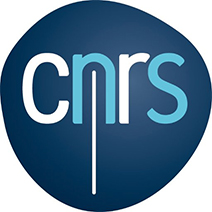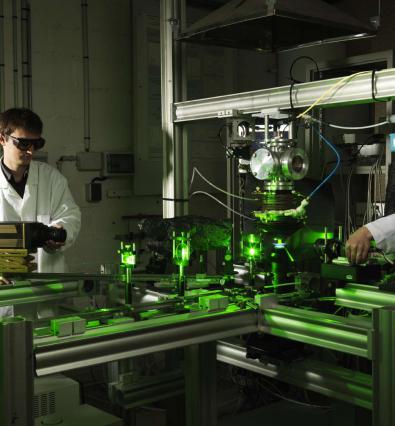

Research Topics
Functional Materials for Energy
-
This line of research looks at and proposes new materials for energy applications, specifically, for nuclear and hydrogen technologies.
-
This line of research involves the Laboratoire de Recherche Conventionné CARMEN (Characterization of Materials for Nuclear Energy Research Laboratory) (CentraleSupélec, CNRS and CEA), which focuses on the properties of ceramics with and without thermodynamic equilibrium. The joint team also studies the influence of preparation conditions on material properties, and the degradation of these properties induced by aging in extreme environments. This is of utmost importance for nuclear applications.
-
This line of research also includes work based around hydrogen materials and technologies. Its objective is to find rupture materials that allow the operation of solid oxide fuel cells at lower temperatures or the clean production of H2 by photolysis. A large amount of work involves transport properties (impedance, complex, conductivity, relaxation) being measured under controlled temperatures and atmospheres.
Advanced Ferroics
This research line focuses on functional oxides with properties that are governed by electrical polarization, mechanical elasticity, magnetic magnetization and the interactions between these quantities, known as ferroics.
Our objective is to:
- design and develop new materials with different scales (crystals, ceramics, thin films, nanowires, nanocomposites, heterostructures, etc.),
- explore new functionalities for potential applications in electronics (ferroelectric memories, acoustic filters, spin electronics, etc.), energy (mechanical energy recovery, electrical storage, photovoltaic storage, etc.), oil (sensors-actuators in oil wells) or living things through biomechanical prostheses,
- better understand microscopic mechanisms (electromechanical, magnetoelectrical, photoelectrical interactions, etc.) involved in these functionalities to optimize the properties and predict their behavior. This research is based on advanced technological methods and tools, from manufacturing and nanostructuring of materials to their modeling, using a broad range of characterization techniques.
Electronics Structures, Modeling and Simulations
The scientific objective of this line of research is the development of innovative methods in theory and through experiment. Popular subjects for theoretical research involve the development of new functionals within Density Functional Theory (DFT) and the incorporation of quantum effects in molecular dynamics. From an experimental point of view, non-photochemical laser induced nucleation (NPLIN) should be mentioned, as well as methods developed for the joint analysis of experimental data from various kinds of experiments. This is a joint operation (ECP, Paris-Sud University Faculty of Pharmacy): for this reason, the study of interactions and biological targets of active substances has always been important. Nevertheless, other systems have been considered, including thermoelectric materials, oxides (optionally under pressure) and surfaces.
Fields of Application
Nuclear industry, ceramics for fourth generation reactors. Functional ceramics: high-capacitance multilayer capacitors, piezoelectric transducers, microsystems, electrostrictive actuators. Biomedical field, pharmaceutical industries, hydrogen technology, fuel cells, hydrogen production, nanostructured ceramic development.
Key Figures
- Instructor-researchers and researchers: 13
- Associate researchers: 6
- Technical and administrative staff: 12
- PhD students in 2016: 13
- Tier A publications (source: Web of Science): 638
Scientific Partners
National :
- CEA Saclay,
- CEA DAM Ile-de-France,
- Paris-Sud University Faculty of Pharmacy,
- Paris-Sud University,
- Pierre and Marie Curie University,
- Institute for Solid State Chemistry Bordeaux,
- Institut Laue-Langevin, European Synchrotron Radiation Facility,
- Laboratoire Léon Brillouin,
- Synchrotron SOLEIL,
- CEA-Leti,
- Université Paris-Est Créteil,
International :
- Waseda University,
- Spring8,
- University of Arkansas,
- EPFL,
- Cracow University of Technology,
- University of Belgrade,
- University of Barcelona, G
- eorgia Tech
Industrial Partners
- Schlumberger,
- NanoE,
- Coorstek,
- Thales and Thales Underwater Systems,
- Ferroperm,
- Imasonic,
- Ixsea (Sonar),
- ST micro,
- Leti,
- Horiba-Jobin Yvon,
- Saint-Gobain
Examples of Work
Understanding nanoscale phenomena in advanced nuclear fuels
Nuclear fuel safety, efficiency, and waste management are fundamental challenges that underpin technology development for advanced nuclear energy systems. The problem of understanding and developing a predictive capability for the evolution of fuels is challenging, even for phenomena that appear simple.
Our research is aimed at understanding microstructural evolutions and phase stability under relevant chemical and physical conditions, chemistry and structural evolution at interfaces, using neutron scattering, numerical models, and spectroscopies (Raman, tracer diffusion, impedance, etc.) in uranium-based oxides and fission-product solutions, representing model nuclear fuels and waste forms. One of the results of our improved description of uranium oxidation on an atomic level is the assessment of a new model for the oxidation kinetics of nuclear fuels in accident scenarios.
MORPHOGENESIS MECHANISMS OF FERROELECTRIC NANO-OBJECTS
Ferroelectric nano-objects are the next-generation bricks for advanced microelectronic. We have recently classified the different mechanisms at play during synthesis of these objects, some of them based on Turing original ideas about competing chemical reactions. We have also shown that depending of the shape of these objects, hyper-toroidal momentum of polarization could be used to build ultra-high density memories.
NON-PHOTOCHEMICAL LASER INDUCED NUCLEATION
NPLIN is a technique that allows the controlling of nucleation through laser light. The laser intensity and polarization (circular, linear) can be used to control the nucleation speed and polymorphic form. Briefly, a LASER light (532 nm, 7 ns, 10 Hz) is applied on a supersaturated i.e. metastable solution of an organic species. Once this solution is submitted to laser light during a short time (typically few seconds), some minutes to hours after, micrometric crystallites are detected via an optical microscope, indicating that nucleation has been induced by LASER.. The term ‘non-photochemical’ is used to indicate that there is no chemical transformation of the molecules.
The potentialities of this method is (i) to be able to produce given structural forms of molecular crystals (ii) to produce high quality crystals with very little defect density [1, 2].
CONTACT
Directeur : Guilhem DEZANNEAU
Tél. : +33 (0)1 41 13 12 11
Fax : +33 (0)1 41 13 14 37
E-mail : guilhem.dezanneau@centralesupelec.fr




